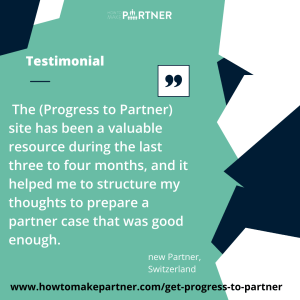This article first appeared in top-consultant.com . If you currently work in a professional services firm, or have ambitions to move into this field, ‘making partner’ is often the holy grail of the career-minded individual. Heather Townsend and Jo Larbie, authors of ‘How to make partner and still have a life’ explain the four different routes to partnership. The route you take to ascend the top of your professional tree will vary hugely depending on the type of firm you work for and your own individual experience, there are, however four main routes to partnership; as follows:
Traditional:
Do your time and work your way up from the bottom – probably the route the more senior partners in your firm would’ve taken. This is becoming less common-place as we more readily move between jobs. If this is the route you’re taking make sure you’ve considered the following: • Your personal values and those of your firm, are closely aligned • Your firm can meet your personal partnership ambitions • You feel at home, that this is the ‘right’ firm in which you have good professional and personal relationships.
Lateral:
The lateral route to partnership has become more common in recent years, with partners chosen from outside of the existing talent pool. It could be that internal staff don’t make the grade or the firm’s looking for someone with specific experience or a valuable client portfolio. You might be thinking about jumping ship to make partner if: • Your current route is being blocked by senior members who will beat you to the top • You face just doesn’t seem to fit, either because of values or personality clashes • Making partner within your current firm doesn’t gel with your personal ambitions • Your existing workplace’s future looks unstable • You simply want variety
In-house:
If you leave private practice and then go back; either working your way up or straight in as partner, this is the ‘in-house’ route. This is a less common way to make partner as candidates are unlikely to have a client following, but there are huge amount of benefits to the firm, namely that potential partners from industry have first-hand experience of the types of clients they will be working with. The reasons for choosing this approach are very similar to the lateral route to partner.
Going it alone:
Instead of trying to make partner in an established firm, you could start up your own practice. This is a very common route to partnership, and often taken-up by those who have spent some time working outside in industry who want full-control of their career. If you want to be your own boss there are three different options: • Buy into an established practice which is for sale. • Buy a franchise. • Start up your own practice from scratch.
Going it alone is not for everyone, but for those with the right entrepreneurial outlook and ambition it promises great rewards, including running a business in a way that suits you with the opportunity for larger financial returns and the possibility to weave work around home life more effectively. As we said at the beginning, every individual’s route to partnership is different but, if you currently have designs on this career move, understanding these routes will help you make an approach that suits your ambitions.
 One of the most sought-after courses in our subscriber-only site Progress to Partner Academy is called “How to Build a Cast-Iron Business Case for Partner”. We think it’s a must-have in your arsenal of tools and guidance to help with your career progression. There is also a section on the Partnership Admissions process with guides and recordings to help you find your way through the system. Check it out!
One of the most sought-after courses in our subscriber-only site Progress to Partner Academy is called “How to Build a Cast-Iron Business Case for Partner”. We think it’s a must-have in your arsenal of tools and guidance to help with your career progression. There is also a section on the Partnership Admissions process with guides and recordings to help you find your way through the system. Check it out!
Author Credit  Heather Townsend helps professionals become the ‘Go-To’ Expert. Along with Jo, she is author of How to make partner and still have a life, and the author of the award-winning and best-selling book on networking, The FT Guide To Business Networking. Jo Larbie is a leading thinker in the world of talent management for professional service firms. She has over 20 years experience in organisational and leadership development and has been personally responsible for many hundreds of professionals taking the step up to partner.
Heather Townsend helps professionals become the ‘Go-To’ Expert. Along with Jo, she is author of How to make partner and still have a life, and the author of the award-winning and best-selling book on networking, The FT Guide To Business Networking. Jo Larbie is a leading thinker in the world of talent management for professional service firms. She has over 20 years experience in organisational and leadership development and has been personally responsible for many hundreds of professionals taking the step up to partner.








